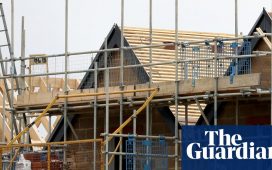Unlock the Editor’s Digest for free
Roula Khalaf, Editor of the FT, selects her favourite stories in this weekly newsletter.
Nearly half of landlords’ income now goes towards covering the costs of running a rental home, underlining the increased burden of mortgage interest bills and other expenses in the private rented sector.
HM Revenue & Customs on Friday published data on individual landlords — as opposed to those in a limited company structure — showing figures on property income and costs for 2022-23, the most recent tax year available.
Analysis of the data by estate agent Hamptons found that costs for private landlords came to 48 per cent of total income, rising from 45 per cent in 2020-21 — even as rents have soared.
Aneisha Beveridge, head of research at Hamptons, said: “The figures out today reveal the mounting cost pressures landlords have faced . . . Double-digit rental growth last year has not been enough to offset the combination of escalating mortgage rates and broader inflationary pressures, which have squeezed profit margins.”
The biggest driver of these cost increases was a 29 per cent jump in the cost of “rents, rates and insurance”. These expenses include ground rents or service charges on a landlord’s leasehold flat, council tax, and buildings and contents insurance. Some of these rises will typically be passed on to tenants, but seldom all.
Finance costs rose by 11 per cent on the year to hit 30 per cent of all costs, as mortgage rates soared following the Liz Truss “mini” Budget of September 2022.
Pointing to the 0.7 per cent decline in the number of landlords declaring rental income on their tax return — equivalent to 16,000 landlords — Hamptons said this was unlikely to indicate a significant exodus from the sector. Some will have sold, it said, but others would have switched their ownership to a limited company structure for tax reasons and others will have paid down their mortgage to alleviate higher tax costs.
Beveridge said: “Despite the financial challenges, landlords are not giving up. Instead, they are adapting to the situation.”
However, accountants UHY Hacker Young warned that there was a steeper fall in the number of small landlords. The number of individuals declaring rental income of less than £10,000 a year fell by 70,000 in the last year, from 1.54mn in 2021-22 to 1.47mn in 2022-23.
It noted the increased financial and regulatory pressures on landlords over the past eight years, with the government introducing a three percentage point stamp duty surcharge on buy-to-let and second homes, and withdrawing the ability of higher rate paying landlords to offset mortgage interest costs against rental income when calculating tax. The tax-free allowance for landlords selling a property has also been cut over the past two years.
Neela Chauhan, a partner at UHY Hacker Young, said: “Many smaller landlords with just one or two properties are finding that the income simply isn’t worth the work any more.”
She also warned over fears that Labour chancellor Rachel Reeves would increase capital gains tax. “A rise in capital gains tax in the Budget is only going to accelerate landlords quitting the buy to let market. Fewer landlords could lead to higher rents.”
While Hamptons downplayed the 2023 data as evidence of mass departures from the sector, more recent figures in 2024 from consultancy TwentyCi and estate agent Savills suggest the sell-up may subsequently have picked up pace.
In the specialist field of furnished holiday lets, a record 130,000 landlords declared income from a let property. However, their total income fell by 21 per cent on the previous year, as the Covid-era boom in “staycations” faded and overseas holidays returned.











